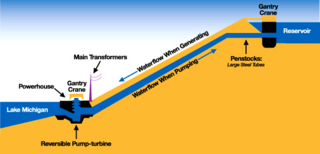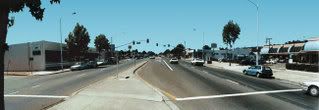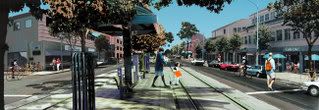( – promoted by buhdydharma )
Excerpted from Burning the Midnight Oil for Living Energy Independence, in the Burning the Midnight Oil blog on the Daily Kos.
Looking ahead … say, two decades ahead, to 2030 … where could we be in terms of a sustainable energy system?
 We could, of course, have large scale wind farms scattered across the Dakotas, parts of Iowa, Kansas, Oklahoma, parts of Texas, Illinois through to western Ohio, through the western parts of California, Oregon, Washington, and the list goes on.
We could, of course, have large scale wind farms scattered across the Dakotas, parts of Iowa, Kansas, Oklahoma, parts of Texas, Illinois through to western Ohio, through the western parts of California, Oregon, Washington, and the list goes on.
 We could have large scale concentrated solar power farms scattered across the Southwest, ranging from Texas to California.
We could have large scale concentrated solar power farms scattered across the Southwest, ranging from Texas to California.
We could have large scale ocean and/or tidal power, as well as offshore windpower, off all three coasts as well as windpower all across Lake Erie and in the shallower portions of the other Great Lakes and Lake Champlain.
 Backing that up, pulling power off of and feeding power into a nationwide inter-regional sustainable power grid, modular pumped storage hydro (that is, tank-to-tank hydro … put a holding tank at the bottom on the right, instead of Lake Michigan), almost anywhere there is an suitable elevation convenient to a sustainable power supply and between a sustainable power supply and a main power consuming area.
Backing that up, pulling power off of and feeding power into a nationwide inter-regional sustainable power grid, modular pumped storage hydro (that is, tank-to-tank hydro … put a holding tank at the bottom on the right, instead of Lake Michigan), almost anywhere there is an suitable elevation convenient to a sustainable power supply and between a sustainable power supply and a main power consuming area.
Backing that up, quite literally “topping up the tank” when the volatile power sources are not delivering the energy being consumed, a distributed network of biocoal power stations, relying on the marriage of “clean coal” technologies (like Direct Carbon Fuel Cells) developed for mineral coal with the advantages of a fuel that had its carbon pulled directly out of the atmosphere over the previous year.
Distributed around the country, decentralized renewable power production by individual household, neighborhoods, towns, cities … smaller scale wind generators, solar power, run of the stream hydro-power. When people talk about putting in an air conditioner, they mean digging a well to circulate water down to cool it off, using the water to cool and partially dehumidify flow of air, with the excess heat their solar water heater creates in the summer time used to drive a desiccant-dehumidifier cycle … with the system running off of photo-voltaic cells and supplementing rather than replacing the regular flow of air through the house.
A clean, renewable … and provided the biocoal feedstock is produced in a sustainable way, sustainable … energy supply. Given the biocapacity of the US, not merely a source of non-outsource-able jobs for meeting our own energy needs, but quite certainly opportunities to export energy intensive products to a world struggling to make the transition to away from the era of cheap petroleum.
But … is that all?
When we change our energy system, we change the way we live
Consider 1790. We relied primarily on sustainable renewable energy … well, potentially sustainable renewable energy at any rate (go back to the point about biofuels … its only as sustainable as the production of the biomass). Wood lots, Windmills that really did use wind to drive a mill, water wheels …
… a different degree of mechanical efficiency, but the same concept as above … if it moves, its potential power, and it can be used.
And we lived primarily in rural areas, farms and small towns, with cities by and large living off the business generated by the network of towns and farms in their hinterlands.
Consider 1890. We relied primarily on coal, and mostly used it to boil water to drive big engines. Some of the big engines had wheels and dragged a whole “train” of wheeled cars behind, all on steel track. Some of the big engines were in one place and generated hydraulic power which drove masses of powered equipment … the “Dark Satanic Mills” as described in Dickens. Some of the big engines were in one place and generated electricity, some of which was being used in the latest high tech invention to allow electric trolley car lines to spread throughout the cities.
The cities were exploding in population, as the railroadification of the continent created national markets for the first time … and many of the brands that we recognize today had already been launched. The trolley car and inter-urban lines were leading to the growth of “sub-urbs”, towns where large numbers of people worked in the nearby large city. Of course, the downtown of these “sub-urban” areas where you caught the interurban or trolley to the city attracted business, and these “sub-urbs” often grew into “urbs” in their own right, spawning their own “sub-urbs”.
Consider 1990. We relied primarily on petroleum, and our transportation system was warped to suit the needs of an Auto-Over-All transportation orthodoxy. We heavily subsidized sprawl development, penalized development financially for being space efficient, channeling tax dollars into creating decentered suburban sprawl and giving tax breaks to businesses for putting in employee parking places but not for covered walkways to quality bus shelters or cycle lockers and shower facilities for cycle commuters.

And for the first time, a majority of Americans lived in places that were neither farm nor town nor city, but something else, spending ever more hours in the week sitting in the car driving or waiting to drive to go somewhere to live our lives.
And 2090? If we continue down the track that the addicts of oil wish to pursue, it won’t be a question of how we live in the United States in 2090, as there won’t be any such thing.
But … we don’t have to continue down that track. We could pursue Sustainable Energy Independence.
And if we do, it will make a difference.

Energy makes a difference in the state of things.
| Midnight Oil – Beds are Burning (1987) Out where the river broke The bloodwood and the desert oak Holden wrecks and boiling diesels Steam in forty five degrees The time has come |
|

23 comments
Skip to comment form
this is beautiful, really beautiful!
On my bike commute, I pass by a lot of vast parking lots. From my perspective on a bike, this is a horrible waste of space. I’m burnt out on America’s car culture and the parking lots somehow depress me a lot. I keep seeing them as community parks, or at least a place where shopping is more compact. But, we worship the car in the U.S. and we equate shopping to patriotism. So, if we could divorce cars and redefine patriotism, maybe we become a different, better nation. One of the ideas I keep coming back to is, what if the automobile didn’t catch on until 100 years later? I imagine American cities would be more compact and, probably, more European in their usability.
would be great for wind farms.
A plain as flat as a billiard table, across which a strong west wind blows.
Bruce.